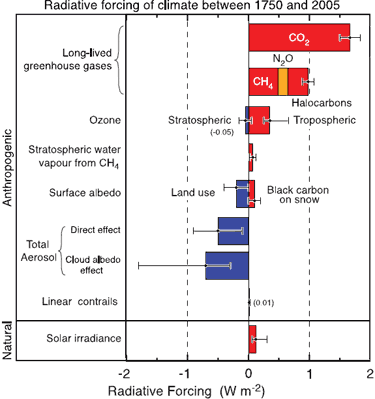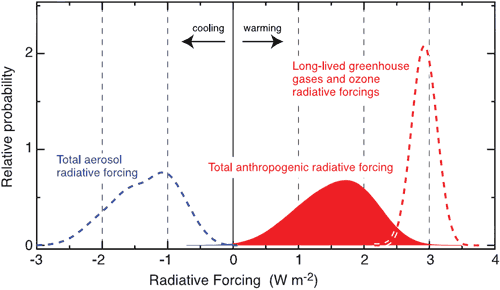
Figure 1: Global mean radiative. Anthropogenic RFs and the natural direct solar RF are shown. (IPCC AR4 Section 2.1)
What The Science Says:
While there are many drivers of climate, CO2 is the most dominant radiative forcing and is increasing faster than any other forcing.
Climate Myth: CO2 is not the only driver of climate
I don’t “deny” climate change or global warming, it is clear to me that the Earth has warmed slightly in the last century, this is indisputable. I also believe that increasing amounts of CO2 in Earths atmosphere are a component of that warming, but that CO2 is not the only driver of climate as some would have us believe. However, what is in dispute (and being addressed by mainstream climate science) is climate sensitivity to CO2 as well as the hiatus in global warming, also known as “the pause”. Since I embrace the idea of warming and that CO2 is a factor, along with other drivers including natural variability, the label “denier” is being applied purely for the denigration value, and does not accurately reflect my position on climate. (Anthony Watts, May 2015)
Understanding what drives climate does not occur by a process of elimination. It's happens by a process of integration. There are many influences of climate that all need to be considered together to gain the full picture. The following lists the radiative forcing, loosely defined as the change in net energy flow at the top of the atmosphere, from the various factors that affect climate (IPCC AR4 Section 2.1). Positive radiative forcing has a warming effect (so obviously, negative radiative forcing has a cooling effect).
Here's a visual summary of the various radiative forcings:

Figure 1: Global mean radiative. Anthropogenic RFs and the natural direct solar RF are shown. (IPCC AR4 Section 2.1)
Putting it all together, Figure 2 compares the warming from human caused greenhouse gases to the total radiative forcing from all human sources.

Figure 2: Probability distribution functions (PDFs) from combining anthropogenic radiative forcings. Three cases are shown: the total of all anthropogenic radiative forcings (block filled red curve); Long-lived greenhouse gases and ozone radiative forcings (dashed red curve); and aerosol direct and cloud albedo radiative forcings (dashed blue curve). Surface albedo, contrails and stratospheric water vapour RFs are included in the total curve but not in the others. Natural radiative forcings (solar and volcanic) are not included in these three PDFs. (IPCC AR4 Figure 2.20b)
Greenhouse gases and ozone contribute warming of +2.9 Wm-2. The majority of this is from CO2 (+1.66 Wm-2). This warming is offset by anthropogenic aerosols, reducing the total human caused warming to 1.6 Wm-2. So the warming from CO2 actually exceeds the final total radiative forcing. The other important point to glean from Figure 2 is that we have a relatively high understanding of greenhouse gas radiative forcing. The probability density function (PDF) shows a much higher probability than the aerosols PDF, meaning the uncertainty associated with greenhouse gas forcing is much lower. This is also confirmed by experimental observations from both satellites and surface measurements which confirm the enhanced greenhouse effect from rising greenhouse gases.
So in summary, there are two reasons for the focus on CO2:
Intermediate rebuttal written by John Cook
Update July 2015:
Here is a related lecture-video from Denial101x - Making Sense of Climate Science Denial
 |
The Skeptical Science website by Skeptical Science is licensed under a Creative Commons Attribution 3.0 Unported License. |